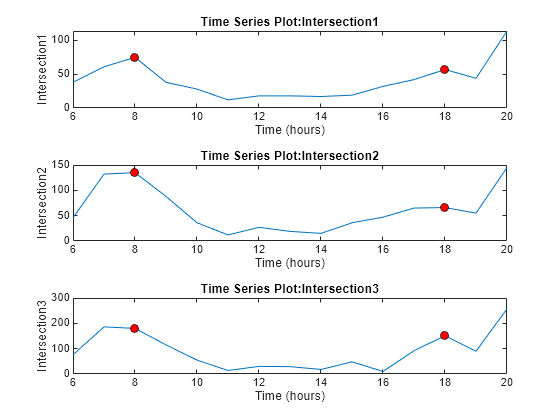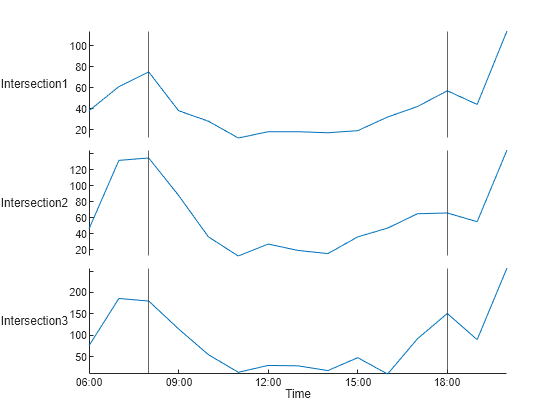timeseries2timetable
说明
TT = timeseries2timetable( 将 ts)timeseries 对象转换为一个时间表。
如果
ts是timeseries对象,则TT是具有一个变量的时间表。如果
ts是由timeseries对象组成的数组,则TT是一个包含的变量数与ts中的timeseries对象数相同的时间表。ts中的所有timeseries对象必须具有相同的采样时间。如果任一
timeseries对象具有多个事件,则该函数将这些事件转换为一个事件表,并将该事件表附加到TT。重复事件会导致事件表中出现重复的行。 (自 R2024b 起)
示例
创建一个包含五个随机数的 timeseries 对象,以 10 秒为间隔进行采样。
ts = timeseries(rand(5,1),[0 10 20 30 40])
timeseries
Common Properties:
Name: 'unnamed'
Time: [5x1 double]
TimeInfo: [1x1 tsdata.timemetadata]
Data: [5x1 double]
DataInfo: [1x1 tsdata.datametadata]
More properties, Methods
显示 ts 中的时间和数据。
ts.Time
ans = 5×1
0
10
20
30
40
ts.Data
ans = 5×1
0.8147
0.9058
0.1270
0.9134
0.6324
将 ts 转换为一个时间表。
TT = timeseries2timetable(ts)
TT=5×1 timetable
Time Data
______ _______
0 sec 0.81472
10 sec 0.90579
20 sec 0.12699
30 sec 0.91338
40 sec 0.63236
创建一个 timeseries 对象数组。使用相同的采样时间向量,但为时间序列提供不同的名称。使用 rand 函数创建不同的数据值数组。
ts1 = timeseries(rand(5,1),[0 10 20 30 40],"Name","Series_1"); ts2 = timeseries(rand(5,1),[0 10 20 30 40],"Name","Series_2"); ts3 = timeseries(rand(5,1),[0 10 20 30 40],"Name","Series_3"); ts = [ts1 ts2 ts3]
1×3 timeseries array with properties:
Events
Name
UserData
Data
DataInfo
Time
TimeInfo
Quality
QualityInfo
IsTimeFirst
TreatNaNasMissing
Length
将来自所有 timeseries 对象的数据合并到一个时间表中。数组中的每个时间序列都为该时间表提供一个变量。
TT = timeseries2timetable(ts)
TT=5×3 timetable
Time Series_1 Series_2 Series_3
______ ________ ________ ________
0 sec 0.81472 0.09754 0.15761
10 sec 0.90579 0.2785 0.97059
20 sec 0.12699 0.54688 0.95717
30 sec 0.91338 0.95751 0.48538
40 sec 0.63236 0.96489 0.80028
将多个 timeseries 对象转换为一个时间表。
ts1 = timeseries(rand(5,1),[0 10 20 30 40],"Name","Series_1"); ts2 = timeseries(rand(5,1),[0 10 20 30 40],"Name","Series_2"); ts3 = timeseries(rand(5,1),[0 10 20 30 40],"Name","Series_3"); TT = timeseries2timetable(ts1,ts2,ts3)
TT=5×3 timetable
Time Series_1 Series_2 Series_3
______ ________ ________ ________
0 sec 0.81472 0.09754 0.15761
10 sec 0.90579 0.2785 0.97059
20 sec 0.12699 0.54688 0.95717
30 sec 0.91338 0.95751 0.48538
40 sec 0.63236 0.96489 0.80028
加载三个 timeseries 对象,这些对象包含三个城市交叉路口的交通数据。
load trafficCounts.mat count1 count2 count3
显示第一个 timeseries 对象的属性。这些属性存储交通数据、收集数据的时间和两个事件。事件是 tsdata.event 对象。
count1
timeseries
Common Properties:
Name: 'Intersection1'
Time: [15x1 double]
TimeInfo: [1x1 tsdata.timemetadata]
Data: [15x1 double]
DataInfo: [1x1 tsdata.datametadata]
Events: [1x2 tsdata.event]
More properties, Methods
显示附加到 count1 的第一个事件。
count1.Events(1)
EventData: []
Name: 'AMCommute'
Time: 8
Units: 'hours'
StartDate: ''
显示第二个事件。这些事件标记早晚通勤的时间。
count1.Events(2)
EventData: []
Name: 'PMCommute'
Time: 18
Units: 'hours'
StartDate: ''
绘制来自三个 timeseries 对象的数据。要创建一个分块图布局以在子图中显示时间序列,请使用 tiledlayout 函数。图显示红点来标记与三个时间序列相关联的事件。
tiledlayout(3,1) nexttile plot(count1) nexttile plot(count2) nexttile plot(count3)

将三个 timeseries 对象转换为一个时间表。将行时间的格式设置为 hh:mm 格式。这些事件在三个时间序列中的相同时间发生,因此时间表在 08:00 和 18:00 都有三个事件标签。
TT = timeseries2timetable(count1,count2,count3);
TT.Time.Format = "hh:mm"TT=15×3 timetable with 6 events
Time Intersection1 Intersection2 Intersection3
_____ _____________ _____________ _____________
06:00 38 46 76
07:00 61 132 186
<3 events> 08:00 75 135 180
09:00 38 88 115
10:00 28 36 55
11:00 12 12 14
12:00 18 27 30
13:00 18 19 29
14:00 17 15 18
15:00 19 36 48
16:00 32 47 10
17:00 42 65 92
<3 events> 18:00 57 66 151
19:00 44 55 90
20:00 114 145 257
该转换还将事件对象转换为一个事件表。该事件表附加到时间表。事件表显示它在两个时间有三个相同的事件。
TT.Properties.Events
ans = 6×1 eventtable
Event Labels Variable: EventLabels
Event Lengths Variable: <instantaneous>
Time EventLabels
_____ ___________
8 hr "AMCommute"
8 hr "AMCommute"
8 hr "AMCommute"
18 hr "PMCommute"
18 hr "PMCommute"
18 hr "PMCommute"
您可以清除包含重复事件的事件表。一种方法是使用 unique 函数。
ET = TT.Properties.Events; ET = unique(ET)
ET = 2×1 eventtable
Event Labels Variable: EventLabels
Event Lengths Variable: <instantaneous>
Time EventLabels
_____ ___________
8 hr "AMCommute"
18 hr "PMCommute"
将清理后的事件表附加到时间表。显示时间表。
TT.Properties.Events = ET
TT=15×3 timetable with 2 events
Time Intersection1 Intersection2 Intersection3
_____ _____________ _____________ _____________
06:00 38 46 76
07:00 61 132 186
AMCommute 08:00 75 135 180
09:00 38 88 115
10:00 28 36 55
11:00 12 12 14
12:00 18 27 30
13:00 18 19 29
14:00 17 15 18
15:00 19 36 48
16:00 32 47 10
17:00 42 65 92
PMCommute 18:00 57 66 151
19:00 44 55 90
20:00 114 145 257
创建一个图,其中包含时间表中的交通数据。首先创建一个新图窗窗口,这样您就不会重用由 tiledlayout 创建的子图。然后,使用 stackedplot 来绘制时间表中的数据。stackedplot 函数将每个时间表变量绘制在一个对应的子图中,并在事件发生的时间处显示黑色竖线。
figure stackedplot(TT)

输入参数
输入时间序列,指定为由 timeseries 对象组成的数组。
此函数使用 ts 的部分属性来分配数据或设置时间表中的属性。对于每个 timeseries 属性,该表描述输出时间表中的结果。
输入 | 输出时间表中的结果 |
|---|---|
| 指定对应时间表变量的名称。 如果 |
| 指定分配给对应时间表变量的数据。 |
| 设置对应时间表变量的 |
| 设置对应时间表变量的 |
| 将采样时间转换为时间表的行时间。根据输入的 |
| 指定行时间的单位。如果时间表行时间向量是 |
| 设置行时间的格式。 |
| 设置时间表的 |
| 设置时间表的 |
| 计算从 |
| 确定数据是否需要重定向。 |
| 指定分配给时间表的 |
| 将事件转换为一个事件表中的条目,并将该事件表附加到时间表。 (自 R2024b 起) 输入时间序列中的重复事件会导致事件表中出现重复行。 |
| 警告。 |
| 如果 |
版本历史记录
在 R2021a 中推出您可以将具有事件的 timeseries 对象转换为具有事件表的时间表。当 timeseries2timetable 将 timeseries 对象转换为时间表时,它也会将所有关联的 tsdata.event 对象转换为一个事件表。然后,该函数将事件表附加到时间表。
在 R2024b 之前,timeseries2timetable 在将 timeseries 对象转换为时间表时会忽略事件。
ts2timetable 函数现在命名为 timeseries2timetable。此函数的行为保持不变,代码中的现有 ts2timetable 实例继续按预期工作。目前没有停止支持对 ts2timetable 的现有引用的计划。
MATLAB Command
You clicked a link that corresponds to this MATLAB command:
Run the command by entering it in the MATLAB Command Window. Web browsers do not support MATLAB commands.
选择网站
选择网站以获取翻译的可用内容,以及查看当地活动和优惠。根据您的位置,我们建议您选择:。
您也可以从以下列表中选择网站:
如何获得最佳网站性能
选择中国网站(中文或英文)以获得最佳网站性能。其他 MathWorks 国家/地区网站并未针对您所在位置的访问进行优化。
美洲
- América Latina (Español)
- Canada (English)
- United States (English)
欧洲
- Belgium (English)
- Denmark (English)
- Deutschland (Deutsch)
- España (Español)
- Finland (English)
- France (Français)
- Ireland (English)
- Italia (Italiano)
- Luxembourg (English)
- Netherlands (English)
- Norway (English)
- Österreich (Deutsch)
- Portugal (English)
- Sweden (English)
- Switzerland
- United Kingdom (English)